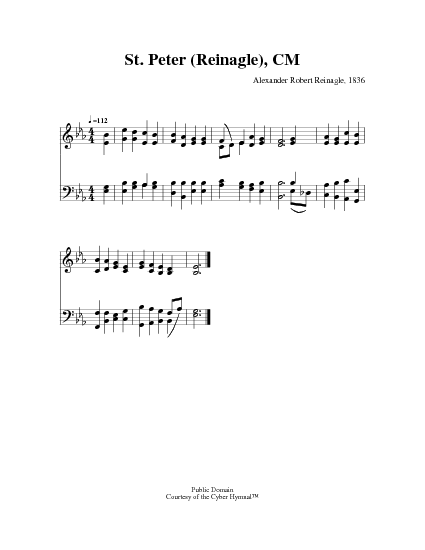- |
User Links
O happy is the man who hears

O happy is the man who hears
Author: Michael BrucePublished in 300 hymnals
Printable scores: PDF, MusicXMLAudio files: MIDI
Representative Text
1 How happy are all they who hear
true Wisdom's guiding voice;
and who her understanding make
their early, only choice.
2 For she has treasures greater far
than east or west unfold;
and her rewards more precious are
than all their stores of gold.
3 In her right hand she holds to view
a length of happy days;
and riches with great honours joined
are what her left displays.
4 She guides the young with innocence,
in pleasure's paths to tread;
a crown of glory she bestows
upon the hoary head.
5 According as her labours rise,
so her rewards increase;
her ways are ways of pleasantness,
and all her paths are peace.
Source: Hymns of Glory, Songs of Praise #686
Author: Michael Bruce
Bruce, Michael, son of a Scottish weaver, was born at Kinnesswood, Portmoak, Kinrossshire, Scotland, March 27,1746, and educated at the village school, Edinburgh University (where he first became acquainted with John Logan), and the Theological Hall of the Associate Synod, held at Kinross, under the Rev. John Swanston, intending ultimately to enter the ministry, a hope which was frustrated by his untimely death. To assist in procuring University fees and maintenance he for some time conducted a school, during the recess, at Gairney Bridge, and subsequently at Forrest Mill, near Tillicoultry. Whilst yet a student he died at Kinnesswood, July 5th, 1767. [Also, see Logan, John] The names of Michael Bruce and John Logan are brought together… Go to person page >Text Information
| First Line: | O happy is the man who hears |
| Author: | Michael Bruce |
| Meter: | 8.6.8.6 |
| Language: | English |
| Copyright: | Public Domain |
O happy is the man who hears. M. Bruce. [Wisdom.] From evidence set forth in our biographical sketch of M. Bruce, we believe the original of this hymn to have been written by M. Bruce about 1764, and that the manuscript of the same was handed to J. Logan by Bruce's father a short time after Bruce's death in 1767. It was published by Logan as his own in his Poems, 1781, p. 104, No. 4, in 5 stanzas of 4 lines. In the same year, a slightly altered version of the text was given in the new and revised edition of the Scottish Translations and Paraphrases, as No. xi., and this has been in authorised use in the Church of Scotland for more than 100 years. It is also found in many English and American collections. The nearest approach to the original text is given in Dr. Mackelvie's Lochleven and other Poems, &c, 1837, p. 258 ; and Dr. Grosart's Works of M. Bruce, 1865, p. 133. The text of the Scottish Translations and Paraphrases, 1781, has been altered in several modern collections to (1) "How blest the man that bends the ear;" (2) "How happy is the child who hears;" (3) "How happy is the youth who hears;" and (4) "Wisdom has treasures greater far."
--John Julian, Dictionary of Hymnology (1907)
Notes
O happy is the man who hears. M. Bruce. [Wisdom.] From evidence set forth in our biographical sketch of M. Bruce, we believe the original of this hymn to have been written by M. Bruce about 1764, and that the manuscript of the same was handed to J. Logan by Bruce's father a short time after Bruce's death in 1767. It was published by Logan as his own in his Poems, 1781, p. 104, No. 4, in 5 stanzas of 4 lines. In the same year, a slightly altered version of the text was given in the new and revised edition of the Scottish Translations and Paraphrases, as No. xi., and this has been in authorised use in the Church of Scotland for more than 100 years. It is also found in many English and American collections. The nearest approach to the original text is given in Dr. Mackelvie's Lochleven and other Poems, &c, 1837, p. 258 ; and Dr. Grosart's Works of M. Bruce, 1865, p. 133. The text of the Scottish Translations and Paraphrases, 1781, has been altered in several modern collections to (1) "How blest the man that bends the ear;" (2) "How happy is the child who hears;" (3) "How happy is the youth who hears;" and (4) "Wisdom has treasures greater far."
--John Julian, Dictionary of Hymnology (1907)
Tune
BALLERMA (Barthélemon)ST. PETER (Reinagle)
Composed by Alexander R. Reinagle (b. Brighton, Sussex, England, 1799; d. Kidlington, Oxfordshire, England, 1877), ST. PETER was published as a setting for Psalm 118 in Reinagle's Psalm Tunes for the Voice and Pianoforte (c. 1836). The tune first appeared with Newton's text in Hymns Ancient and Mode…
ST. STEPHEN (Jones)


 My Starred Hymns
My Starred Hymns





